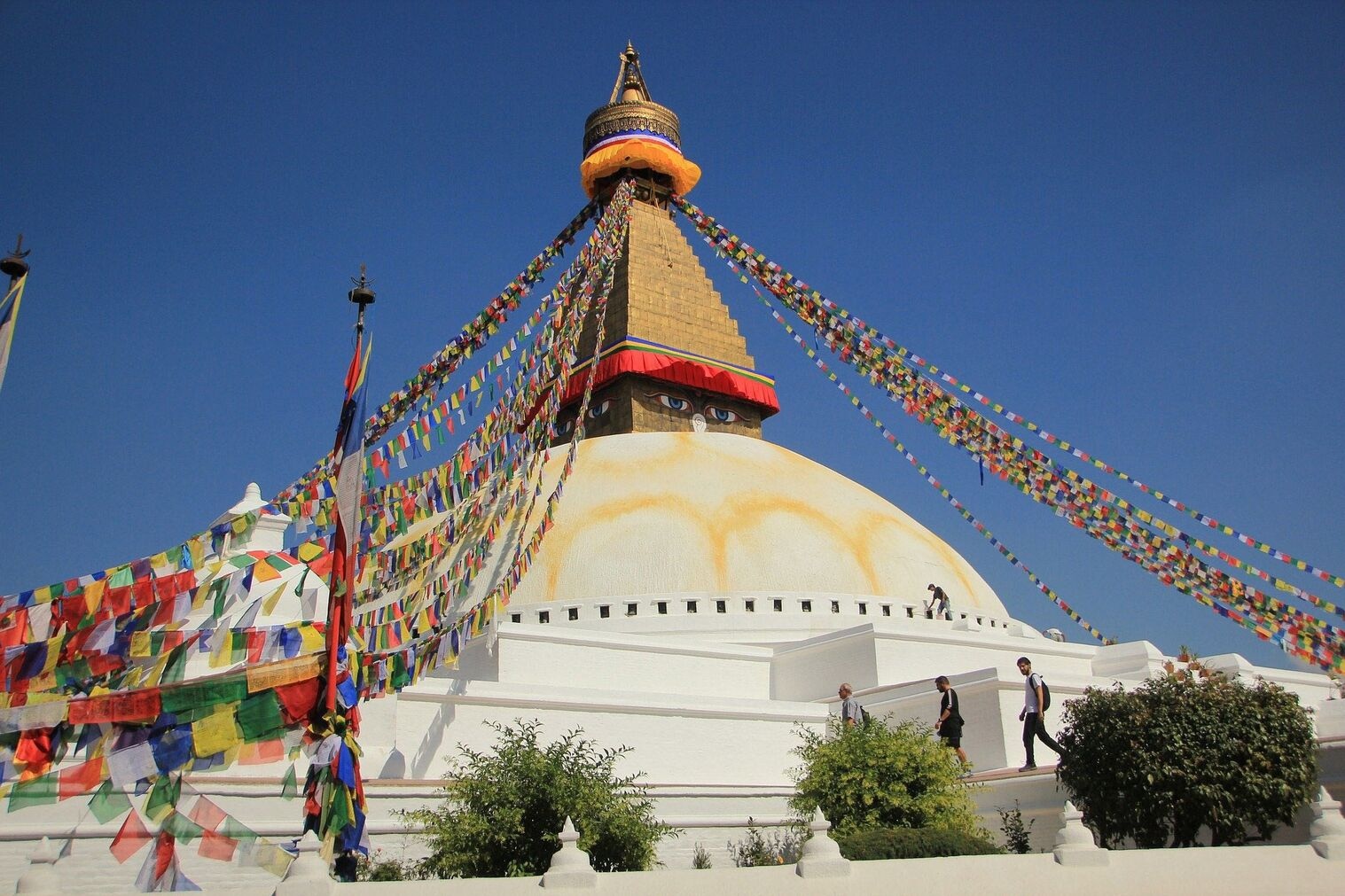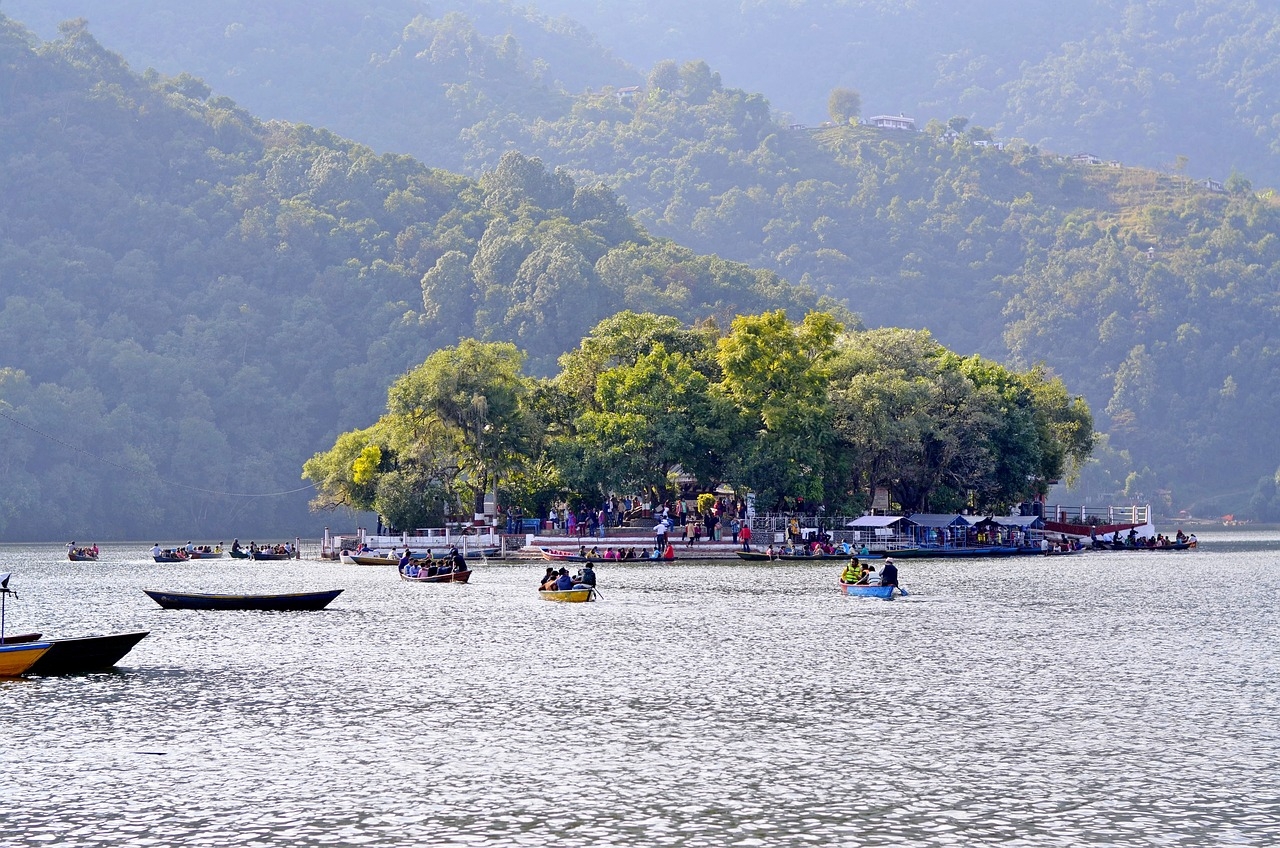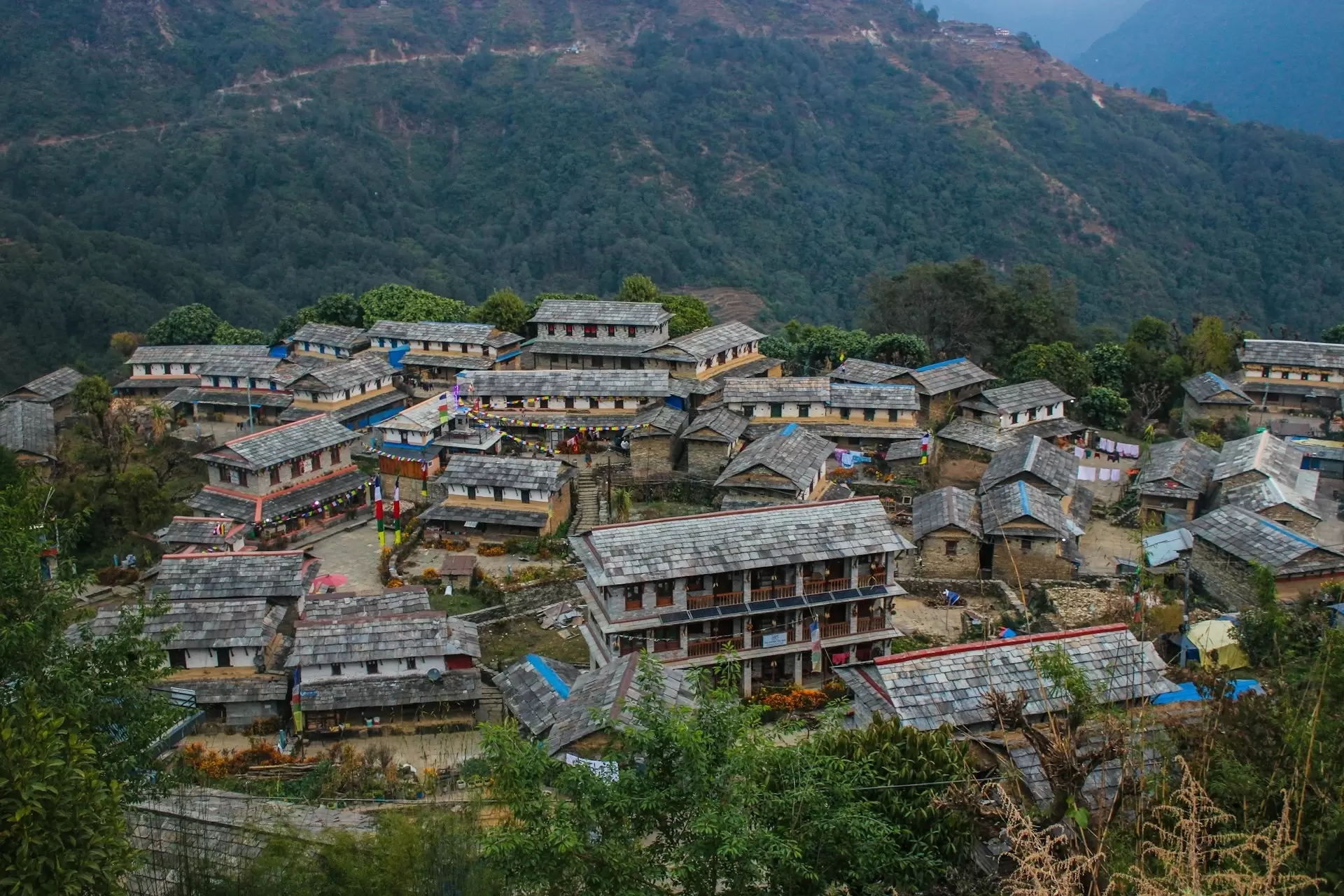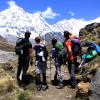After you arrive at the international terminal of Kathmandu airport, you will be warmly welcomed by our company representative. You will be picked up from the airport and taken to a hotel by the Himalayan Forever staff. When you arrive at the hotel, check out your incredible rooms, and then, once you've had a chance to rest, visit the Himalayan Forever office for a meeting.




After breakfast, a city and cultural tour guide from Himalayan Forever will meet you at the hotel for an exciting day city tour drive. The drive passes through Kathmandu's historical Durbar Square and Palace Courtyard. It is the right place to witness Nepalese cultures and offers the views of ancient monuments listed in UNESCO World Heritage Sites. Our next stop is Swayambhunath Stupa, which carries a history of 2,600 years. It is a Buddhist monument that is one of Nepal's most well-known landmarks and is located on a hillside west of Kathmandu.
Kathmandu Durbar Square:
Kathmandu Durbar Square, also known as Hanuman Dhoka Square, stands as a testament to the city's royal history. Surrounded by ancient palaces, courtyards, and temples, this UNESCO World Heritage Site encapsulates centuries of Nepalese architecture. The square served as the royal palace for the Malla kings and later the Shah dynasty.
Upon entering, visitors are greeted by the magnificent Hanuman Dhoka Palace, a complex adorned with intricately carved wooden windows and doors. The Kumari Ghar, home to the living goddess Kumari, adds an air of mystique to the square. The Kumari, a prepubescent girl chosen as the living embodiment of the goddess Taleju, occasionally makes appearances at her window, captivating onlookers.
Exploring the narrow alleys surrounding the square reveals hidden courtyards, shrines, and vendors selling traditional artifacts. The combination of historical charm and vibrant street life makes Kathmandu Durbar Square an unforgettable destination.
Pashupati Nath:
A short journey eastward leads to the sacred grounds of Pashupati Nath, one of the holiest Hindu temples in the world. Nestled on the banks of the Bagmati River, Pashupati Nath is dedicated to Lord Shiva and draws pilgrims from across the globe.
The main temple, adorned with intricate wood carvings and golden spires, stands as the focal point of the complex. Only Hindus are allowed into the inner sanctum, but visitors can witness the rituals and ceremonies from the eastern bank of the river. The atmosphere is infused with spirituality as devotees perform rituals, sadhus (holy men) meditate, and the scent of incense wafts through the air.
Pashupati Nath is not only a religious site but also a reflection of Nepal's rich architectural heritage. The surrounding area, with its ancient statues, shrines, and ghats, provides a serene backdrop to this spiritual haven.
Boudha:
Heading northeast from Pashupati Nath, the journey culminates at the iconic Boudha Stupa, a symbol of Buddhism and a UNESCO World Heritage Site. The colossal white dome, adorned with the watchful eyes of the Buddha, dominates the landscape, creating a serene and contemplative ambiance.
The Boudha Stupa is encircled by a bustling market, where locals and tourists alike peruse a plethora of shops offering Tibetan artifacts, prayer flags, and traditional handicrafts. The rhythmic prayer chants, the spinning of prayer wheels, and the fluttering of colorful flags create a mesmerizing atmosphere.
The stupa itself is a marvel of symmetry and symbolism. Pilgrims circumambulate the structure, spinning prayer wheels and offering prayers, while monks in nearby monasteries engage in their daily rituals. As the sun sets, the stupa is illuminated, casting a tranquil glow that adds to the spiritual aura.
Our guide will drive you back to the hotel for lunch. You will get ready for an exciting scenic flight to Nepalgunj city located in the Far Mid-South West Nepal where you will spend the night.








Enjoy the views of Annapurna Himalayas while having early morning breakfast and depart from the hotel. Take an exciting drive from Pokhara towards a scenic countryside. After few hours of pleasant drive, the route diverts on the dirt trail from Nayapul town to Bhirethati village.
Drive alongside the Modi River for a while, before reaching on winding uphill route to Ghandruk. It is a popular and aesthetic village around southern Annapurna Himalayas, and Gurung are the main tribes of Ghandruk and Annapurna Himalaya region.
Our team will arrange you a nice lodge for overnight stay in Gandruk. Before that, you can enjoy the afternoon free time by exploring the village of Ghandruk. You may also visit the small Gurung museum that provides best information of the Gurung people and of the Annapurna region.



Get ready for a long and exciting six hours hike towards Chomrong village after having breakfast. The route starts from Ghandruk village towards Kimrong ridge. You can find number of houses serving as lodges and restaurants around Kimrong river valley. After having lunch in Kimrong village, hike through uphill trail which leads to Chomrong village.
Follow the easy gentle winding stone paved path and you will reach Chomrong village for overnight halt. It is a large Gurung settlement and the last permanent village on route to Annapurna base camp and sanctuary.



Hike downhill alongside Chomrong stream, and then climb through stone steps towards Sinuwa Danda, a small hill top area with houses serving like lodges, shops. Rest there for a while and follow through a winding forested path which leads to Bamboo, which is located on a forest full of bamboo trees, rhododendron and pine tree lines.
From there, hike uphill through a dense forest alongside Modi River gorge, before reaching a beautiful settlement of Dovan. Overnight stay in Dovan and enjoy the sound of raging Modi River.



From Dovan, hike early in the morning alongside a beautiful waterfall and Modi River. You'll get closer to large overhanging Hinko Cave, and then reach Himalaya Hotel.
Take a short rest and hike downhill on rocky path and then climb through open field which leads to Deurali, a nice place with several nice lodges. Enjoy your lunch there prepare for a big climb towards MBC (Machhapuchare Base Camp). Walk alongside Modi River which leads to steep climb and small bamboo grooves before reaching MBC. Overnight stay in nice local lodge. This place is situated beneath towering peak of Machhapuchare Himal(the famous Fish-Tail peak).




Enjoy the heavenly views of Annapurna-I, Annapurna South and Huin-Chuli peaks with a morning breakfast. Then, start a short climb to enter a plateau of Annapurna Sanctuary. You can see a welcome signboard of Annapurna Base Camp(ABC) eventually. It is the only 8,000 meters base camp which has nice cozy lodges, and restaurants at 4,130 m high, surrounded by towering snow-capped peaks.
At reaching ABC, enjoy the glorious panorama of snowy mountain range from the lodge. You can spent the leisure afternoon time by viewing the surrounding arctic landscapes. Stay in the ABC for the night.



While in ABC, enjoy the wonderful time around scenic Annapurna Sanctuary, and continue to walk downhill from MBC. Hike towards Bamboo which goes through an easy downhill route leading back into dense forest. We finally complete the long walk from ABC to Bamboo and stay there for the night.









On this day, you will be driving back from Pokhara to Kathmandu. Based on your departure schedule, you can go to Kathmandu Durbar Square in Thamel and explore the historic palace and museum. In addition to enjoying authentic Nepali food, you can also choose what to buy for souvenirs at Thamel. Overnight stay at Kathmandu.
(You can also fly from Kathmandu to Pokhara in 35 minutes if you choose more ease and luxury. If you do so, you will have more time to explore Pokhara and engage in different activities like cycling and boating.)



This is your last day in Nepal and you should get ready for final departure as per your international flight time. You will be escorted to the airport by the Himalayan Forever Trek guide and team. Our guide and staff will bid you a farewell as you depart for your country. You will surely never forget this wonderful experience and adventure of Upper Dolpa Trekking. Namesty!

The Annapurna Base Camp Trek requires two main permits: the Annapurna Conservation Area Permit (ACAP) and the Trekkers' Information Management System (TIMS) card. These permits are essential for trekking in the Annapurna region and are obtainable through registered trekking agencies such as Himalayan Forever. They contribute to conservation efforts and ensure safety and support for trekkers by regulating entry and monitoring trekking activities.
The journey typically begins with a scenic drive from Pokhara to Nayapul or Phedi, depending on the chosen route. From Nayapul or Phedi, trekkers commence their trek on foot, following well-marked trails that wind through picturesque villages, terraced fields, and lush forests. Internal transportation during the trek primarily involves hiking, with occasional use of local jeeps or buses for shorter segments, depending on the itinerary.
The trek starts from Nayapul or Phedi, where trekkers begin their ascent through the Modi Khola valley. The trail passes through quaint villages like Ghandruk, inhabited by Gurung communities known for their hospitality and rich cultural heritage. As the trek progresses, the landscape transitions from subtropical forests to alpine meadows, offering stunning views of Machhapuchhre (Fish Tail), Hiunchuli, and other peaks of the Annapurna range.
The Annapurna Base Camp Trek culminates at Annapurna Base Camp (4,130 meters), surrounded by towering peaks such as Annapurna I (8,091 meters), Annapurna South, and Machhapuchhre. Trekkers are rewarded with breathtaking sunrise views over the snow-clad mountains, creating a mesmerizing Himalayan panorama. After descending from Annapurna Base Camp, the trek retraces its steps back to Nayapul or Phedi, followed by a drive back to Pokhara.
Communication facilities along the Annapurna Base Camp Trek route are limited and may be available in larger villages like Ghandruk or Chhomrong. Mobile network coverage can be sporadic or absent at higher altitudes. It's advisable to inform family and friends beforehand about potential communication challenges and rely on satellite phones or trekking agency support in emergencies.
The Annapurna Base Camp Trek is considered moderate in difficulty. It involves daily hikes of approximately 5-7 hours over varied terrain, including steep ascents and descents. Trekkers should have a reasonable level of fitness and be prepared for altitude gains up to 4,130 meters. Proper acclimatization, pacing oneself, and staying hydrated are crucial to mitigate altitude-related risks.
Accommodation along the Annapurna Base Camp Trek ranges from basic tea houses with shared facilities to more comfortable lodges with private rooms in larger villages like Chhomrong and Bamboo. Tea houses offer simple yet hearty meals, including dal bhat (rice and lentils), noodles, and Tibetan bread, catering to trekkers' dietary needs. Accommodation and meals are typically included in trekking packages provided by Himalayan Forever, ensuring comfort and sustenance throughout the journey.
The Annapurna Base Camp Trek spans approximately 10-12 days, depending on the itinerary and pace. The best times to undertake this trek are spring (March to May) and autumn (September to November). During these seasons, the weather is generally stable with clear skies, mild temperatures, and blooming rhododendrons along the trails, enhancing the trekking experience with stunning mountain views and comfortable hiking conditions.
Spring and autumn are ideal for the Annapurna Base Camp Trek due to favorable weather conditions, minimal precipitation, and excellent visibility of the surrounding peaks. These seasons also coincide with cultural festivals in the region, offering trekkers opportunities to witness local traditions and celebrations.
Himalayan Forever's team for the Annapurna Base Camp Trek consists of experienced trekking guides and support staff who are knowledgeable about the route, local cultures, and safety protocols. They provide personalized assistance, ensure trekking logistics run smoothly, and offer insights into the natural and cultural wonders of the Annapurna region throughout the journey.
Trekkers should be mindful of the high-altitude nature of the trek and take necessary precautions to prevent altitude sickness. It's recommended to acclimatize properly, drink plenty of fluids, and follow the guidance of trekking guides and support staff. Travel insurance covering trekking activities and emergency evacuations is essential for peace of mind.
Himalayan Forever stands out for its commitment to responsible tourism practices, safety standards, and client satisfaction. With customized itineraries, experienced guides, and a deep respect for local cultures and environments, Himalayan Forever ensures that trekkers have a memorable, safe, and enriching experience on the Annapurna Base Camp Trek. Their attention to detail, personalized service, and dedication to environmental conservation make them a trusted choice for trekking adventures in Nepal.
The Annapurna Base Camp Trek offers a remarkable blend of natural beauty and cultural encounters. Highlights include exploring the diverse landscapes of the Annapurna Sanctuary, encountering local wildlife and flora, and witnessing sunrise views over the majestic Himalayan peaks from Annapurna Base Camp. The trek also allows for interactions with friendly villagers, visits to ancient monasteries, and relaxation in natural hot springs at Jhinu Danda, providing trekkers with a profound connection to Nepal's mountainous landscapes and cultural heritage.
Is it possible to extend the Annapurna Base Camp Trek or customize the itinerary?
Yes, Himalayan Forever offers options to customize the trekking itinerary or extend the journey to include side trips or additional days for exploration, depending on the preferences of the trekkers.
What type of footwear and clothing are recommended for the Annapurna Base Camp Trek?
Sturdy hiking boots with ankle support, moisture-wicking clothing suitable for layering, a warm jacket, and a good quality sleeping bag are recommended. A detailed packing list is provided by Himalayan Forever prior to the trek.
Are there ATM facilities along the trekking route?
ATM facilities are limited and generally available only in major towns like Pokhara. It's advisable to carry sufficient cash for expenses during the trek, as credit card acceptance is limited.
What level of physical fitness is required for the Annapurna Base Camp Trek?
Participants should have a good level of fitness and stamina to trek for several hours each day over varied terrain and high altitudes. Prior trekking experience is beneficial but not mandatory.
Is altitude sickness common on the Annapurna Base Camp Trek?
Altitude sickness can affect trekkers at higher elevations. Proper acclimatization, hydration, and recognizing symptoms are crucial. Guides are trained to assist in such situations.
What should I pack for the Annapurna Base Camp Trek?
Essentials include sturdy hiking boots, layered clothing for varying temperatures, a sleeping bag, sunscreen, and a refillable water bottle. Trekking poles are recommended for stability.
Can I trek solo or is a guide necessary?
While solo trekking is possible, hiring a guide is recommended for safety, navigation, and cultural insights. Guides also assist with permits, accommodation, and emergency situations.
How do I prepare physically for the trek?
Cardiovascular exercises, strength training, and hiking practice with a weighted backpack can improve stamina and readiness for trekking at higher altitudes.
The Annapurna Base Camp Trek promises an unforgettable adventure amid the majestic Himalayas, where every step reveals a new facet of Nepal's natural and cultural heritage. Whether trekking with a group or independently, the journey to Annapurna Base Camp leaves trekkers with enduring memories and a profound connection to the mountains.
Himalayan Forever Treks orchestrated an exceptional Annapurna Base Camp Trek for me. Their meticulous planning and experienced guides ensured a seamless journey through awe-inspiring terrain. The views of the Annapurna range were simply breathtaking. The team's hospitality and knowledge of the region added immense value to the trip. From cozy accommodations to delightful local cuisine, every aspect was well-curated. Kudos to Himalayan Forever Treks for an unforgettable adventure that exceeded all expectations! Thanks to Himalayan Forever Treks, I achieved an incredible feat while feeling safe and inspired throughout.

Prakash and the team or the best at what they do! I would say that after many investigations into the best trekking companies, Himalayan Forever is one of the best with years of experience!

My wife and I visited Nepal in two consecutive years. The first trip was in the Poona region , We stayed in guesthouses. The second trip took us in the Gurkacounty and thh Anapurna mountains. This time we slept in tents. During both trips Prakash looked after us with great care from the moment we arrived in Kathmandu till we left Nepal. The carriers of our luggage and the equipment were both very friendly and helpful too. The organisation of both trips was excellent and contributed to our experiences far above our expectations hey rank definately in the top three our our trips made all over the worldMichael the netherlands
The trek was wonderful, and I felt confident because Himalayan Forever are really friendly and professional. They organised everything and my guide and porter became good friends.
I recently completed the Annapurna Base Camp Trek with Himalayan Forever Treks, and it was an unforgettable experience. The team was professional, knowledgeable, and attentive to our needs throughout the journey. The stunning views, well-planned itinerary, and excellent accommodations made the trek even more enjoyable. I highly recommend Himalayan Forever Treks for a fantastic Himalayan adventure!
The Annapurna Base Camp Trek was a sanctuary for the soul. Surrounded by towering peaks, each step brought me closer to a serene haven. The journey was a perfect blend of challenging trails and moments of absolute tranquility.
Embarking on the Annapurna Base Camp Trek was like stepping into an alpine wonderland. The diverse landscapes, challenging mountain passes, and the breathtaking panoramas from the base camp made every day an adventure.
Annapurna Base Camp is where mountain majesty unfolds. The grandeur of the peaks, the pristine beauty of Machapuchare, and the sense of accomplishment upon reaching the base camp created a trekking experience of unparalleled magnificence.
Witnessing the sunrise at Annapurna Base Camp was a luminous spectacle. The glow of the Himalayan peaks as the first light kissed them was a magical experience. This trek is a journey through nature's gallery, painted with hues of the rising sun.
Summiting Annapurna Base Camp was more than a physical feat; it was a journey to find serenity amidst the peaks. The challenges of the trek, the camaraderie with fellow trekkers, and the sheer beauty of the base camp made it an unforgettable adventure.
Meals on the journey to Annapurna Base Camp are simple but nutritious and include local dishes like momos (dumplings), dal bat (a rice and lentil dish), and several types of curries. Additionally, tea and coffee are frequently served.
In general, meals are provided at guesthouses that are simple, locally owned accommodation and offers the facilities like beds, blankets, and electricity. It's important to keep in mind that the food during the ABC trek may not always meet Western standards.
The best times are spring (March to May) and autumn (September to November) when the weather is stable, and the views are clear.
Yes, trekkers need permits, including the Annapurna Conservation Area Permit (ACAP) and the TIMS (Trekkers’ Information Management System) card.
Both options are possible. The trail is well-marked, making independent trekking feasible. However, hiring a guide and/or porter can enhance the experience and provide support.
Annapurna Basecamp trek is Moderate-difficult and it is not as challenging as other renowned trekking trials. ABC trial compromises some very steep areas and high altitudes but has a good path most of the way.
It takes a few days of hiking to reach Annapurna Base Camp, with maximum elevations of 4,130 m (13,550 ft). Additionally, the Annapurna region has a higher oxygen level than other challenging trekking regions like the EBC. It is because this area has lush woods at low altitudes.
The cost of your trip to Annapurna Base Camp depends on the length of the walk, the season, the kind of accommodation, and the extra services you choose. A typical seven-day trip to Annapurna Base Camp is between $500 and $1,500 on average and comprises services like a guide, porter, meals, and accommodation. There are several methods to find less expensive solutions, such taking a shorter route, staying in a less expensive hotel, and more.
Carry some local money (Nepalese rupees) with you so you can pay for meals, lodging, and any other services you might need. It is crucial to have cash on hand because credit cards are typically not accepted in the isolated villages.
You should bring a certain amount of money, depending on the kind of journey you're doing and your personal spending habits. If you visit through a tour operator, the cost of the trek will normally include meals, accommodation, and transportation. Therefore, you just have to budget for extra services and optional items like souvenirs and snacks.
The Annapurna Base Camp Trek is a popular trekking route in the Annapurna region of Nepal, leading to the base camp of Mount Annapurna. It's renowned for its diverse landscapes and spectacular mountain views.
The trek typically takes around 10-14 days, depending on the chosen route, acclimatization days, and individual trekker's pace.
The highest point is Annapurna Base Camp itself, situated at an elevation of approximately 4,130 meters (13,549 feet).
The trek passes through traditional villages, allowing trekkers to experience local culture and interact with Gurung and Magar communities.
Focus on cardiovascular fitness, endurance, and leg strength. A gradual acclimatization process is essential, and proper trekking gear is necessary.
Side trips to places like Poon Hill can be added for those with extra time, providing additional scenic views.
Follow Leave No Trace principles, respect local customs, and dispose of waste responsibly. Carry a reusable water bottle and minimize the use of single-use plastics.
All of your gear for the Annapurna Base Camp Trek should be put inside a backpack. These gears include a trekking backpack, a sleeping bag, short trekking poles, a first aid kit, a duffle bag, hiking boots, extra-thick or extra-thin socks, gloves, and more. The ideal size bag pack should usually be between 35 and 55L.
Similarly, talking about clothing, a few pairs of exercise leggings or hiking pants will do. Even though it's cold outside, the moment you start trekking, your body temperature will begin to rise.
| No of people | Price per person |
|---|---|
| 1 - 1 | $1,200 |
| 2 - 4 | $1,090 |
| 15 - 20 | $970 |
| 10 - 14 | $999 |
| No of people | Price per person |
|---|---|
| 1 - 1 | $700 |
| 2 - 4 | $599 |
| 5 - 9 | $575 |
| 10 - 13 | $555 |
| 14 - 20 | $530 |
| No of people | Price per person |
|---|---|
| 1 - 5 | $3,500 |
| Group Joining - Per | $799 |
